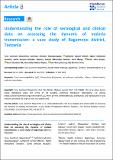| dc.contributor.author | Mwamlima, Tunu | |
| dc.contributor.author | Mwakasungula, Solomon | |
| dc.contributor.author | Mkindi, Catherine | |
| dc.contributor.author | Tambwe, Mgeni | |
| dc.contributor.author | Mswata, Sarah | |
| dc.contributor.author | Mbwambo, Stephen | |
| dc.contributor.author | Mboya, Michael | |
| dc.contributor.author | Draper, Simon | |
| dc.contributor.author | Silk, Sarah | |
| dc.contributor.author | Mpina, Maxmillian | |
| dc.contributor.author | Vianney, John-Mary | |
| dc.contributor.author | Olotu, Ally | |
| dc.date.accessioned | 2023-10-13T06:35:35Z | |
| dc.date.available | 2023-10-13T06:35:35Z | |
| dc.date.issued | 2022-10-07 | |
| dc.identifier.uri | https://www.panafrican-med-journal.com/content/article/43/60/full | |
| dc.identifier.uri | https://dspace.nm-aist.ac.tz/handle/20.500.12479/2301 | |
| dc.description | A research article is submitted in Research | Volume 43, Article 60, 07 Oct 2022 | en_US |
| dc.description.abstract | Introduction: naturally acquired blood-stage malaria antibodies and malaria clinical data have been reported to be useful in monitoring malaria change over time and as a marker of malaria exposure. This study assessed the totalimmunoglobulin G (IgG) levels to Plasmodium falciparum schizont among infants (5-17 months), estimated malaria incidence using routine health
Facility-based surveillance data and predicted trend relation between anti-schizont antibodies and malaria incidence in Bagamoyo. Methods: 252 serum samples were used for assessment of total IgG by enzyme-linked immunosorbent assay and results were expressed in arbitrary units (AU).147/252 samples were collected in 2021 during a blood-stage malaria vaccine trial [ClinicalTrials.gov NCT04318002], and 105/252 were archived samples of malaria vaccine trial conducted in 2012 [ClinicalTrials.gov NCT00866619]. Malaria incidence was calculated from outpatient clinic data of malaria rapid test or blood smear positive results retrieved from District-Health-Information- Software-2 (DHIS2) between 2013 and 2020. Cross-sectional data from both studies were analyzed using STATA version 14. Results: this study demonstrated a decline in total anti-schizont IgG
levels from 490.21AU in 2012 to 97.07AU in 2021 which was related to a fall in incidence from 58.25 cases/1000 person-year in 2013 to 14.28 cases/1000 person-year in 2020. We also observed a significant difference in incidence when comparing high and low malaria transmission areas and by gender. However, we did not observe differences when comparing total anti-schizont
antibodies by gender and study year.
Conclusion: total anti-schizont antibody levels appear to be an important serological marker of exposure for assessing the dynamic of malaria transmission in infants living in malaria-endemic regions. | en_US |
| dc.language.iso | en | en_US |
| dc.publisher | African Field Epidemiology Network | en_US |
| dc.subject | Total immunoglobulins (IgG) | en_US |
| dc.subject | Plasmodium | en_US |
| dc.subject | falciparum | en_US |
| dc.subject | anti-schizont antibodies | en_US |
| dc.subject | infants | en_US |
| dc.subject | clinical malaria | en_US |
| dc.subject | malaria transmission | en_US |
| dc.title | Understanding the role of serological and clinical data on assessing the dynamic of malaria transmission: a case study of Bagamoyo district, Tanzania | en_US |
| dc.type | Article | en_US |

